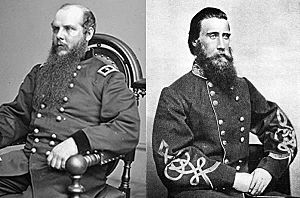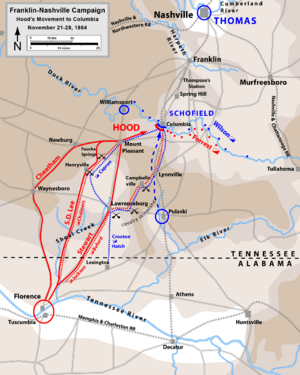Battle of Columbia facts for kids
Quick facts for kids Battle of Columbia |
|||||||
|---|---|---|---|---|---|---|---|
| Part of the American Civil War | |||||||
 Army commanders Schofield and Hood |
|||||||
|
|||||||
| Belligerents | |||||||
| Commanders and leaders | |||||||
| John M. Schofield | John Bell Hood | ||||||
| Units involved | |||||||
| XXIII Corps IV Corps |
Army of Tennessee | ||||||
| Strength | |||||||
| 28,000 | 35,000 | ||||||
| Casualties and losses | |||||||
| unknown | unknown | ||||||
The Battle of Columbia was a series of military actions during the American Civil War. It happened in Maury County, Tennessee, from November 24 to 29, 1864. This battle was part of the larger Franklin–Nashville campaign. It marked the end of Confederate Lt. Gen. John Bell Hood's journey from northern Alabama. His Confederate Army of Tennessee reached Columbia, Tennessee, and crossed the Duck River.
A Union force was led by Maj. Gen. John Schofield. They fought against Hood's cavalry, commanded by Maj. Gen. Nathan Bedford Forrest. The Union soldiers set up defenses south of Columbia. But they soon moved north across the Duck River, leaving the town. Hood's invasion of Tennessee continued. He tried to stop Schofield's army at Spring Hill.
Contents
The Battle of Columbia: A Civil War Chase
Why This Battle Happened
After losing the Atlanta Campaign, General Hood wanted to draw Maj. Gen. William T. Sherman into a fight. He hoped to cut off Sherman's supply lines. Sherman decided to march from Atlanta to Savannah, Georgia, instead. This was known as his March to the Sea.
Sherman left forces to defend Tennessee and defeat Hood. These forces were under Maj. Gen. George H. Thomas. Thomas commanded the Army of the Cumberland. His main units were the IV Corps and the XXIII Corps. The IV Corps was led by Maj. Gen. David S. Stanley. The XXIII Corps was led by Maj. Gen. John Schofield.
Hood's Big Plan
Hood moved his army through northern Alabama. His troops crossed the Tennessee River near Florence. This happened from October 30 to November 2. The rest of his army waited south of the river. Hood waited for nearly three weeks. He needed supplies for his upcoming campaign. Getting supplies was very hard.
Hood also waited for Maj. Gen. Nathan Bedford Forrest. Forrest was on a cavalry raid. He had just won the Battle of Johnsonville. On November 16, Hood learned Sherman was leaving Atlanta. Hood couldn't go back to Georgia to stop Sherman. So, he focused on a new plan.
He would move north into Tennessee. He aimed to defeat Thomas's army quickly. Then, he would capture Nashville. After that, he hoped to go north into Kentucky. Maybe even as far as the Ohio River. From there, he could join Gen. Robert E. Lee in Virginia. His commander, Gen. P.G.T. Beauregard, told Hood to act fast. He needed to move before Thomas could gather all his forces.
Union Generals Get Ready
Both Sherman and Thomas thought Hood would follow Sherman into Georgia. Thomas got reports that Hood was gathering supplies to move north. But he didn't believe most of them. Heavy rains in November made the roads very muddy.
When Thomas heard about Confederate movements north of Florence, he was unsure. Schofield thought it was just a raid by Forrest's cavalry. By November 21, Thomas knew Hood's whole army was moving. He told Schofield to slowly move north. Schofield needed to protect Columbia before Hood could take it.
Schofield arrived at Pulaski on November 13. He took command of all Union forces there. Thomas was still worried. About 10,000 troops from the XVI Corps had not arrived. These reinforcements were led by Maj. Gen. Andrew J. Smith.
The Race to Columbia
Hood's army left Florence on November 21. They marched toward Waynesboro. They reached it on November 23. The army marched in three columns. Forrest's cavalry rode in front. Hood wanted to gather his army at Mount Pleasant. From there, he planned to cut off Schofield. He wanted to stop Schofield from reaching Columbia and the Duck River.
The march was 70 miles north. It was a very hard journey. Freezing winds and sleet made it difficult. The soldiers were hungry and didn't have enough warm clothes. Still, Hood's men were in good spirits. They were happy to be back in Tennessee.
Forrest's Cavalry in Action
Schofield didn't know where the Confederate army was going. This was because Forrest's cavalry kept them hidden. Forrest had a big advantage over the Union cavalry. The Union cavalry was led by Maj. Gen. James H. Wilson. Wilson had only 4,300 horsemen. They were spread out in many small groups. Forrest had 10,000 men, all together.
Confederate cavalry reached Mount Pleasant by November 23. Brig. Gen. John T. Croxton's Union brigade was greatly outnumbered. Thomas sent more troops to help him. These included a division under Brig. Gen. Edward Hatch. Also, a brigade under Col. Horace Capron.
Forrest kept up the attack. On November 23, there was heavy fighting. It stretched from Henryville to Mount Pleasant. That evening, Confederate cavalry raided one of Capron's camps. They caused chaos and captured over 50 prisoners. Forrest almost got caught himself. He accidentally rode into a small group of Union soldiers. A Union soldier aimed his pistol at Forrest. But one of Forrest's officers pushed the soldier's arm away. The bullet missed Forrest. Capron's remaining soldiers ran toward Columbia.
To the east, Forrest's divisions pushed Hatch's division back. They drove them from Lawrenceburg toward Pulaski.
Early on November 24, Schofield began marching his two infantry corps north. They were heading to Columbia. Forrest chased them closely. His division, led by Brig. Gen. James R. Chalmers, took Mount Pleasant. They attacked Capron's men many times. Capron's brigade shrank from 1,200 to 800 men during the retreat.
Forrest's other divisions also pushed Hatch north. They captured many prisoners. But the Confederate cavalry could not stop the Union infantry. The Union soldiers reached Columbia. Brig. Gen. Jacob D. Cox's 5,000-man division arrived just hours before Forrest. Stanley's corps also arrived. They had marched 30 miles from Pulaski. Together, they started digging trenches south of the town.
Facing Off at Columbia
On November 24, Forrest's cavalry pushed Capron's men through Cox's line. This was south of Columbia. They started small attacks. They tried to break through the Union defenses. The Union line was near the Mount Pleasant Pike. It went east across the Pulaski Pike into town. Then it curved north toward the river.
By November 25, another line was built. This one was inside the town. The Confederates fired cannons at the Union lines. There were many small fights. But the Union defenders soon realized something. Only one Confederate infantry division was attacking. Hood was just pretending to attack. He planned to cross the Duck River somewhere else. He wanted to cut off the Union forces from Thomas. Thomas was gathering more troops in Nashville.
Tricking the Union Army
On November 26, Schofield got an order from Thomas. He was told to hold the north bank of the Duck River. He needed to wait for reinforcements. These were A. J. Smith's troops from Nashville. Schofield planned to move his supply wagons during the day. He would move his infantry overnight. They would use a railroad bridge and a new pontoon bridge. But heavy rains made the roads to the bridge impassable. That evening, most of Hood's army reached the defenses south of Columbia.
On November 28, Forrest crossed the river east of town. There was little Union resistance. The Southern cavalry had tricked Wilson. They drew his forces away to the northeast. At the same time, Hood left most of Lee's corps and his cannons at Columbia. He wanted Schofield to think he was planning a big attack on the town. Instead, Hood marched his other two corps across the Duck River. They used a pontoon bridge at Davis's Ford.
What Happened Next
No official casualties were recorded at the "Battle of Columbia." This was because it was mostly about showing force and moving troops. There was also artillery fire. Hood's army went around Schofield's position at Columbia. They then moved north toward Spring Hill. Their goal was to trap the Union force and destroy it.


